
Łódź is my home town in Poland and I love it. But first it would be helpful if I tell English readers how to pronounce this obscure word in which almost every letter has an accent which completely changes its sound. Say “woodshed” but miss off only the final “ed” sound. Now you have it! In case you are interested in the meaning of the name, the word Łódź simply means a small boat.
Łódź – a bit of history
Łódź was an industrial city. The first image which will come to the mind of a Pole when you mention its name will be one of grey, dark cotton mills and the industrial labourers’ tenement housing which went with it. But that image became outdated a decade ago as the city reinvented itself. I loved the stern grey face of Łódź when I was a child and I love the clean colourful sparkling city which it has become in recent years.
But first things first, a bit of history will perhaps explain how the place has a richer culture than you might expect from its recent past. Modern Łódź was born in the nineteenth century from a mixture of four nations and four cultures, Polish, Jewish, German and Russian. The city was actually established in the fifteenth century but it remained a very small town until industrial investment hit it like a bushfire two hundred years ago.
State incentives, cheap labour and a vast Russian market, hungry for cotton fabrics encouraged private investors to generate faster industrial and economic growth in Łódź than had ever occurred in Europe before. It became the Polish answer to Manchester on steroids. Industrial entrepreneurial Łódź was a tolerant and progressive environment. It had vast influx of foreign investment, and powered by steam and former agricultural labour. The city grew rapidly with red brick cotton mills, the flamboyant palaces of wealthy factory owners and the cheap tenements of an exploding labour force.
But by the mid twentieth century, the white heat of growth was cooling off, and had been replaced by soot and grime. In my lifetime, Łódź was considered by everyone in Poland as a boring dead town of black chimneys, derelict factories and grey walls.
And then old factories started to be converted into cool lofts, modern commerce moved in, and grey walls gradually became covered with colourful murals. At the turn of the twenty first century Łódź started blooming again, with the revitalisation of the vast Manufaktura complex as its flagship.
Things to do in Łódź
Visit Manufaktura
Manufaktura is probably the most famous place in modern Łódź. It is a sparkling modern mixed-use development built on the beautifully conserved red brick fabric of a textile factory so large that it had its own streets and squares. Still standing at the gateway of the development is the huge white stone palace of Izrael Poznański, the Jewish entrepreneur and factory owner who was so rich that he once considered flooring his palace with gold coins.
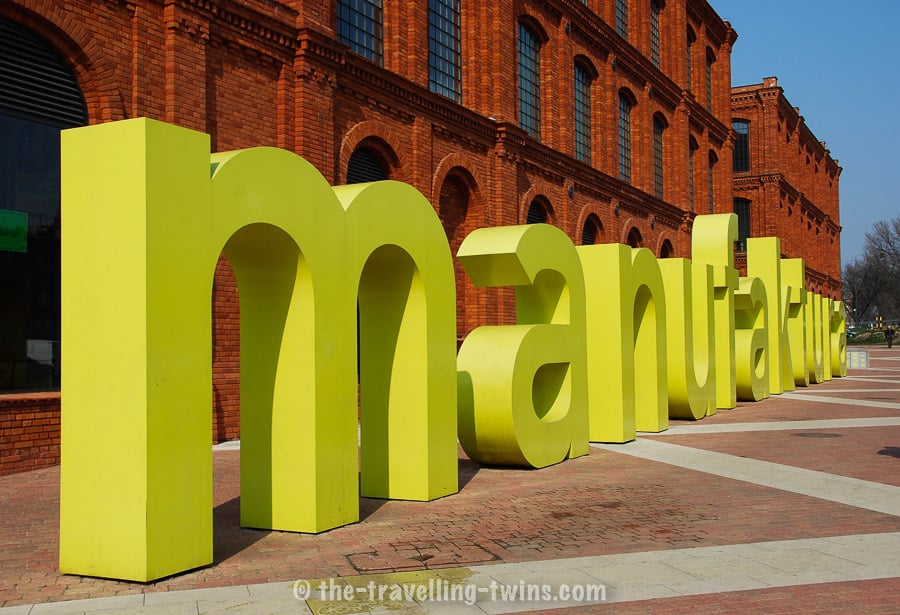
Manufaktura today integrates historic and modern buildings and open space – all beautifully constructed and landscaped. I remember it as the grim place where my father worked in the declining textile industry of late Polish communism. As a child, I would wait for him by the factory gates to finish work. Then it was abandoned, empty and derelict. Teenage me would climb up on the rotting roofs to run and take cool photos. Silly and dangerous. Now it is bustling with new life where everyone can find something to enjoy. It’s the place to be. Some say the reinvented Manufaktura is too commercial, too “Disney” and that it has lost its soul. I think it has gained a new one.
So what is in Manufaktura?
- A range of restaurants and cafes surrounding a vast courtyard.
- A large two level shopping mall with large sports, electronics and building materials stores as well as a supermarket and numerous shops and eateries.
- A multi screen cinema with adjoining games arcades
- A Contemporary Art Museum – MS2
- The Factory Museum – where you can learn the history of Łódź
- Experimentarium – an awesome place to visit with kids
- In the summer in the middle of Manufaktura you will find a big sand beach and in the winter, an ice skating rink.
- Part of the original factory and running alongside Manufaktura is the new four star Vienna House Andel’s Łódź hotel with 4.7/5 point reviews and a striking rooftop pool cantilevered in a glass box high above the plaza.
- Adjacent, the vast Palace of Izrael Poznański is now the City Museum
Walk Piotrkowska Street
Piotrkowska street was and is the axis of the city. Before the days of bypasses, it was the main street leading out of Łódź to the city of Piotrkow Trybunalski. Now Piotrkowska at 5 km is the longest shopping street in Europe. Most of Piotrkowska is pedestrianised. It is a great place to stroll all day, browsing the stores and enjoying one coffee shop after another. Whenever you are there, look up. Above the busy shop fronts remain the historic nineteenth century elevations of the proud city in its heyday.
Find sculptures of the famous Poles connected to Lodz
Dotted along Piotrkowska, brass statues honour historic Polish citizens in lifelike poses. The poet Julian Tuwim is one of these, famous especially for his poems for children. His likeness sits on a bench, its brass nose gleaming since students believe that rubbing it will bring them good luck in their exams.
Three historic factory owners gather around a table: Izrael Poznański, Karol Scheibler and Henryk Grohman. They were known as the three kings of Łódź’s textile industry.
Nobel prize laureate Władysław Reymont is there too. His great novel “The Promised Land” (Ziemia Obiecana) – tells the story of three friends and the challenges they face in setting up a factory in Łódź two centuries ago. It portrays perfectly the spirit of the industrial city and its hunger for growth and success. The movie adaptation by Andrzej Wajda of this novel is an epic, and one of my lifelong favourites.
An image of Artur Rubinstein plays a life sized grand piano with a great feathered wing rising from the piano case, while a great brass treble clef lies alongside to form a bench. This is perhaps the least successful monument in the series . Urban legend says that when Rubinstein’s wife saw the monument she said that it was so ugly that she would never visit the city again. It’s true, the sculpture is not a thing of beauty, but then arguably neither was he.
When you walk or cycle along Piotrkowska don’t forget to visit the courts of old Tenement houses. Some of them have changed a lot.
Pasaz Rozy – Piotrkowska 3
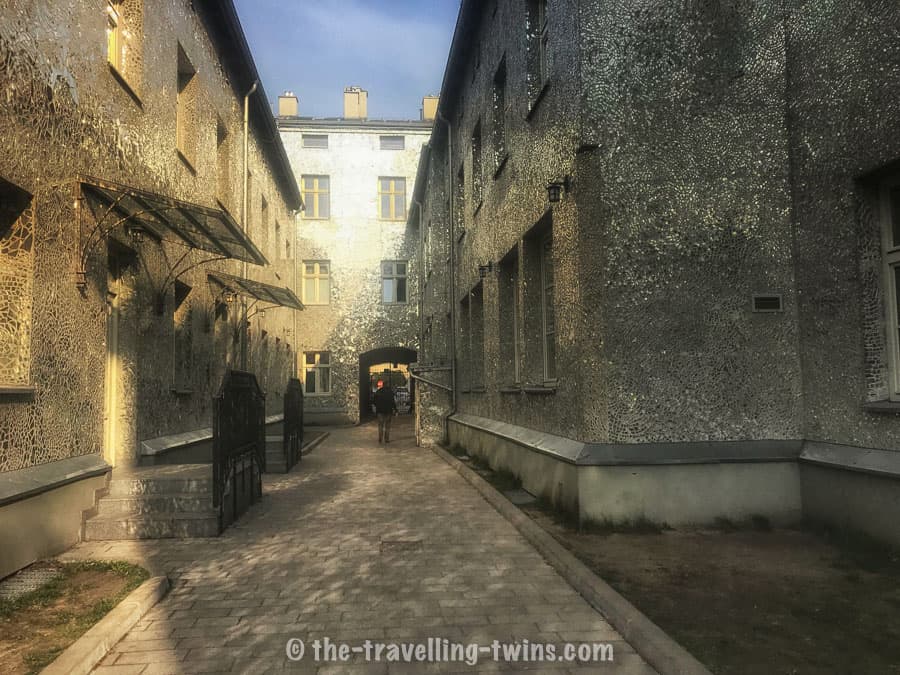
Pasaz Rozy was once a typical Łódź tenement court. Once grey, dirty and ugly, from 2013, it was transformed by artist Joanna Rajkowska as she gradually clad the walls in a mosaic of mirror tile. Now all the walls are covered with mirrors and they change with the light and the weather. The installation was very personal for the artist as when she started it her daughter was diagnosed with eye cancer. The work echoes her struggle with sickness and a celebration of sight.
Visit Off`Piotrkowska
For foodies a visit to Off-Piotrkowska is a must. This multiuse development is located just behind Piotrkowska 138-140 in the converted Ramisch Cotton Factory. It is principally a rented workspace block, but it is also full of cool artisan restaurants open to all. If you want to sit in a deckchair and sip margaritas in the middle of the city then Off-Piotrkowska has this vibe. Probably one of the coolest places to be in Łódź, right now, if you want the best Ramen or Pho in the city, then Off-Piotrkowska has you covered.
Unicorn stable
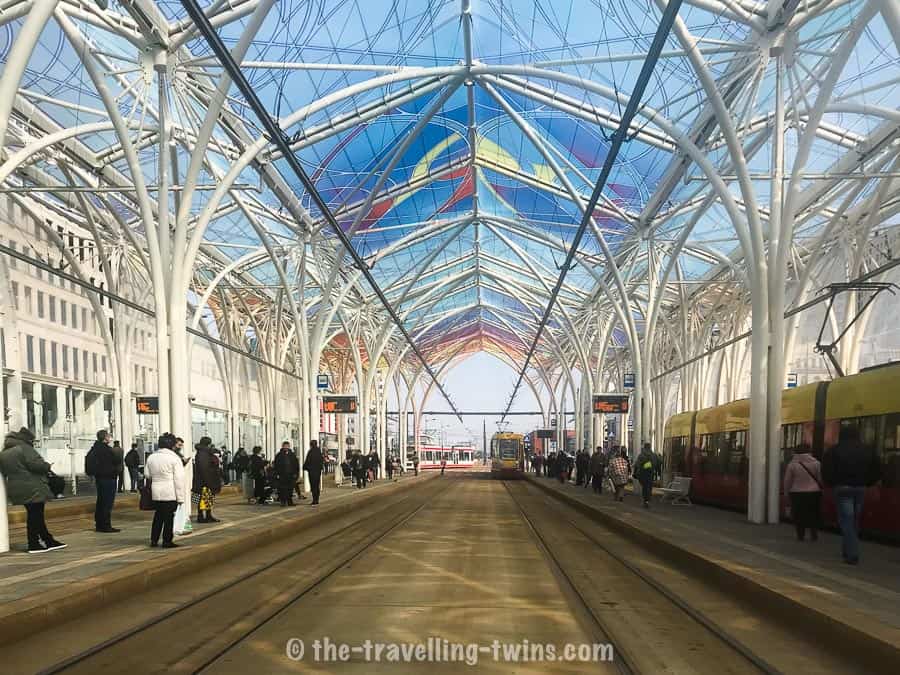
Łódź was waiting a long time for a new tram station until the City organized an architectural competition resulting in a fantastic new structure reminiscent of Calatrava’s Oriente Station in Lisbon but with the added feature of a multicoloured transparent roof. The moment that Lodzians saw it, the tram station gained the popular nickname of the Unicorn Stable. Why? no one knows but the name stuck until a few years later a unicorn statue was added and the title of Łódź Unicorn Stable became official.
Look for Murals
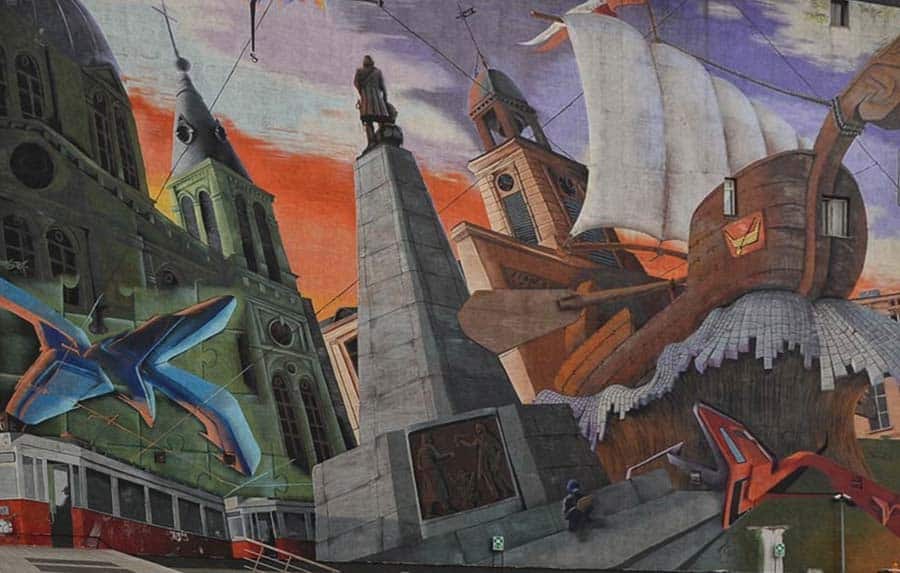
The Łódź of my childhood had lots of blank grey walls. Many of these were gables of tenements facing empty land plots after buildings which had been destroyed during the war or by demolition. Now many of these walls are covered with interesting murals. Perhaps one day I will catalogue them, but for now I will mention two of the most important- the City Of Łódź Mural, and the Artur Rubinstein Mural
The biggest mural in Europe – at 600 square metres is at Piotrkowska 152. Known as the City of Łódź mural, it shows symbols and significant places in the city.
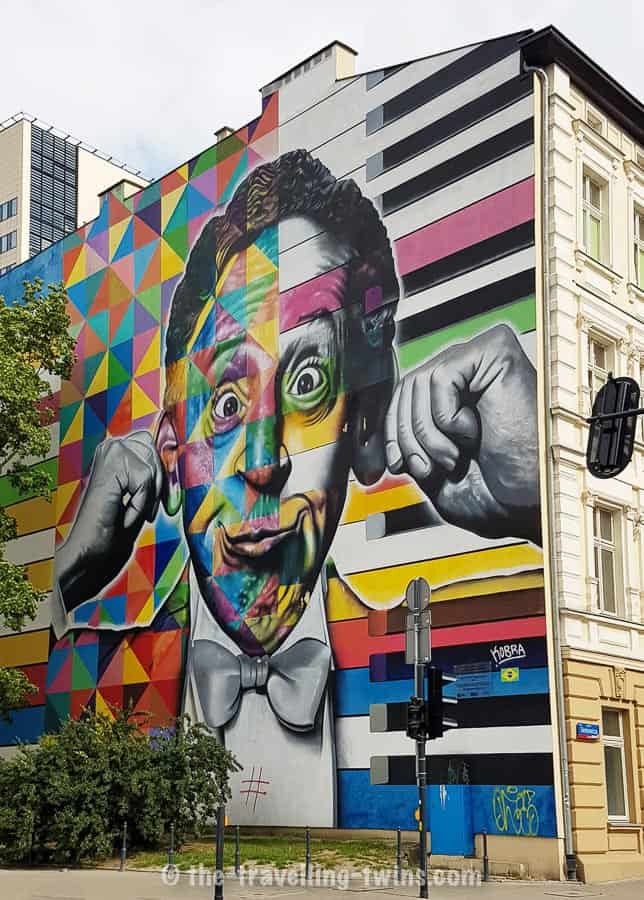
Artur Rubinstein, the subject of a brass sculpture described above, was a Polish American pianist born here. He is considered to be one of the greatest pianists ever, and Łódź is very proud of him. His mural done by Brazylian artist Kobro is located opposite the Philharmonic – The Arthur Rubinstein Philharmonic!
Visit EC1 Lodz – City of Culture
EC1 was an old district-heating plant, built in 1907. It was transformed into a cultural education facility whilst preserving the historic communist architecture.
In EC1 you will find Centre of Science, The most modern Planetarium in Europe, The Comics Centre, National Centre of Cinematography and more. The place is very impressive in its own right, even without all the individual attractions and well worth a visit.
Favourite evening activity in Łódź for adults
My favourite evening activity in Łódź is pub crawling. Along Piotrkowska you will find any number of pubs and beer gardens. You just have to pick one and then decide on which direction to go after that. Then just keep going from one to another bumping into friends, and strangers. Besides having great food, many of Łódź’s bars have amazing funky interiors, so don’t be surprised if you find yourself in a toilet with Venetian mirrors, and a glass floor.
What to do in Łódź with kids
If you are visiting Łódź with kids, the city has some enormous parks and gardens. All of them have playgrounds, places to ride bicycles, and places to explore.
Our favourite parks include
- Park Mickiewicza – located in the North part of town
- Park na Zdrowiu – located in the center of Lodz
- Botanic Garden
- Zoological Garden
Where to stay in Lodz
For me it’s easy, I’m staying in my mum’s place, but if I would recommend something it would be Vienna House Andel’s Łódź four star hotel – right alongside Manufaktura. We stayed there once as a treat and it was super. Very classy interiors and great food.
Other places to stay.
There are lots of AirBnBs alongside Piotrkowska. It the perfect place especially towards the north within easy walking distance of both Łódź Fabryczna railway station and Manufaktura.
Visit Łódź – Conclusion
I hope I have persuaded you that Łódź worth at least a weekend visit. Just remember to arrive on Friday so you will have enough time to do all that Pub crawling.
Łódź what to do – Pin it and share it
